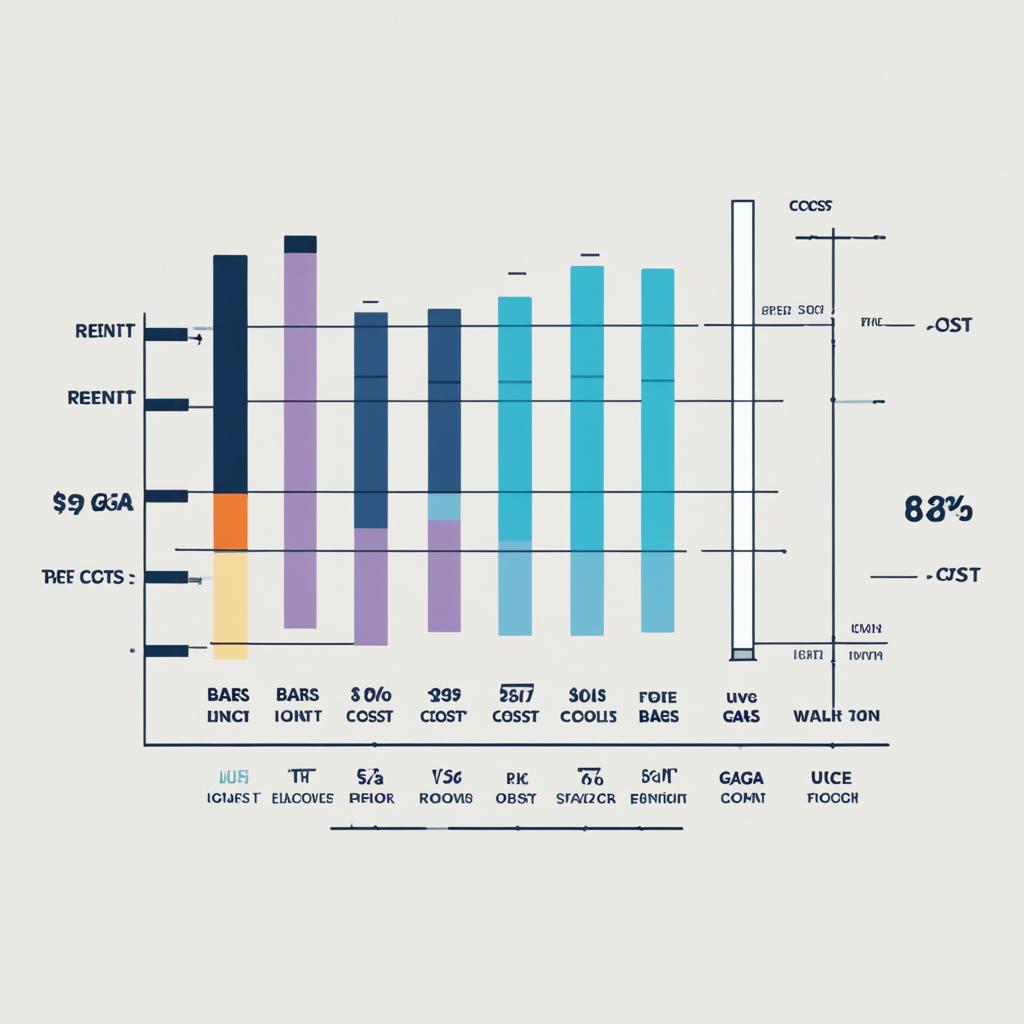Living on a $1000 monthly budget can be challenging, but with some smart budgeting strategies and cost-cutting measures, it is possible to make ends meet. In this article, I will explore practical tips and insights on how to live frugally and stretch your dollars.
Key Takeaways:
- Creating a budget and tracking expenses is crucial for managing a $1000 monthly budget.
- Consider sharing living expenses by getting roommates or listing your space on Airbnb.
- Cooking at home, planning meals, and buying in bulk can help reduce food expenses.
- Explore affordable healthcare options and programs that offer assistance for healthcare coverage.
- Focus on paying off debts and negotiate with creditors for more manageable payment plans.
Get Your Personal Finances Straight
Living on $1000 a month requires careful management of personal finances. To successfully navigate this budget, it is crucial to take control of your financial situation and make necessary changes to your spending habits. Here are some effective tips and budgeting strategies to help you stay on track:
Create a Monthly Budget
Start by creating a comprehensive budget that outlines your monthly income and expenses. A budget allows you to allocate your limited funds to essential categories such as rent, utilities, groceries, and transportation, while also accounting for savings and debt payments.
Track Your Expenses
To gain a clearer understanding of your spending patterns, diligently track your expenses. This can be done through various methods, such as using a budgeting app, keeping receipts, or manually recording your transactions. By closely monitoring where your money goes, you can identify areas where you can cut back and make adjustments.
Eliminate Unnecessary Spending
Identify discretionary expenses that are not essential for your daily needs, such as dining out, entertainment subscriptions, or impulsive shopping. Cut back on these expenses to free up more money for essential items and savings. Consider alternatives to costly activities, such as finding free or low-cost entertainment options in your local community.
“By closely monitoring where your money goes, you can identify areas where you can cut back and make adjustments.”
Remember, living on a tight budget requires discipline and commitment. Focus on prioritizing your needs over wants and making conscious spending choices. By managing your personal finances effectively, you can make the most of your $1000 monthly budget and work towards financial stability.
Budgeting Tips Summary:
| Budgeting Tips | Description |
|---|---|
| Create a Monthly Budget | Allocate your income to essential expenses and savings. |
| Track Your Expenses | Maintain a record of your spending patterns. |
| Eliminate Unnecessary Spending | Identify and cut back on discretionary expenses. |
Rethink Your Living Situation
When it comes to living on a tight budget, housing is often one of the biggest expenses. However, there are several strategies you can implement to make it more affordable and manageable. Consider the following options:
Get Roommates
If you’re living alone, consider getting roommates to share the rent and utilities. Splitting the cost of housing with others can significantly reduce your monthly expenses, allowing you to allocate more funds towards other essential needs.
Listing on Airbnb
If you have extra space in your home, you can consider listing it on platforms like Airbnb to generate additional income. Renting out a spare room or your entire place on a short-term basis can help offset your housing costs and even provide some extra money for savings or other expenses.
Explore Cheaper Living Options
If your current housing situation is financially unsustainable, it may be worth exploring cheaper alternatives. This could involve temporarily moving back home with family or friends while you save up or relocating to areas with a lower cost of living. By adapting your living situation to align with your budget, you can free up more funds for other essential expenses.
“By adapting your living situation to align with your budget, you can free up more funds for other essential expenses.”
Remember, adjusting your living situation may require some sacrifices, but it can significantly impact your overall financial well-being. Take the time to assess your options, consider your priorities, and make the necessary changes that will allow you to live within your means.
| Pros | Cons |
|---|---|
| Reduced housing expenses | Potential loss of privacy and personal space |
| Additional income through Airbnb | Responsibility of managing and hosting guests |
| Flexibility to move to more affordable areas | Disruption of familiar routines and social connections |
By reevaluating your living situation and exploring these options, you can find ways to reduce your housing expenses and create a more sustainable budget. This will give you greater financial stability and peace of mind as you navigate the challenges of living on a tight budget.
Slash Your Food Budget
When it comes to living on a tight budget, one of the most effective ways to save money is by slashing your food budget. By implementing some money-saving hacks, you can still enjoy delicious meals without breaking the bank.
1. Cook at Home and Avoid Eating Out
Instead of dining out or ordering takeout regularly, try to cook at home as much as possible. Not only is it more cost-effective, but it also allows you to have better control over your ingredients and portion sizes. Plus, cooking at home can be a fun and rewarding experience!
2. Plan Your Meals
Meal planning is a great way to save both time and money. By creating a weekly or monthly meal plan, you can shop more efficiently, reduce food waste, and avoid impulse purchases. Plan your meals based on what’s on sale or in season to maximize your savings.
3. Buy in Bulk
Buying in bulk can save you a significant amount of money in the long run. Look for deals on staple items and ingredients that have a longer shelf life, such as grains, pasta, canned goods, and frozen vegetables. Just be mindful of the expiration dates and storage requirements of bulk purchases.
4. Look for Deals and Discounts
Be on the lookout for deals, discounts, and coupons when grocery shopping. Check online platforms, newspapers, and local flyers for weekly specials and promotions. Consider joining loyalty programs or signing up for newsletters from your favorite stores to receive exclusive offers.
5. Get Creative with Leftovers
Leftovers can be transformed into new and delicious meals, saving you money on groceries and reducing food waste. Get creative with your leftovers by incorporating them into salads, wraps, stir-fries, or casseroles. Not only will you save money, but you’ll also add variety to your meals.
6. Explore Free Food Options
There are often opportunities to access free food through food pantries, community events, or local organizations. These resources can provide essential support during periods of financial strain. Do some research to find out what options are available in your area.
By implementing these money-saving hacks, you can slash your food budget without sacrificing flavor or nutrition. Remember, every dollar counts when you’re living on a tight budget.
| Money-Saving Hacks for Your Food Budget | Estimated Savings |
|---|---|
| Cooking at home and avoiding eating out | $100-$200 per month |
| Meal planning | $50-$100 per month |
| Buying in bulk | $20-$50 per month |
| Looking for deals and discounts | $30-$50 per month |
| Getting creative with leftovers | $20-$30 per month |
| Exploring free food options | Varies |
By incorporating these money-saving strategies into your daily routine, you can significantly reduce your food expenses and free up more money for other essential needs.
Lower Your Healthcare Costs
When living on a tight budget, healthcare costs can pose a significant financial burden. However, there are strategies to help minimize these expenses and ensure you have access to the care you need without breaking the bank.
Shop Around for Affordable Health Insurance Plans
One effective way to lower your healthcare costs is by exploring affordable health insurance plans. Take the time to research different options and compare pricing and coverage. Look for plans that offer the services you require at a price that fits your budget.
Avoid jumping at the first plan you come across. Instead, carefully review the details, including deductibles, copayments, and out-of-pocket maximums. Keep your specific healthcare needs in mind to ensure the plan covers the services you utilize most frequently.
Consider Off-Exchange Plans
In addition to traditional health insurance plans, it’s worth considering off-exchange plans. These plans may provide more flexibility and potentially lower monthly premiums compared to marketplace plans. Although they may have different eligibility requirements, exploring off-exchange options can help you find the most cost-effective solution for your healthcare needs.
Government Programs and Assistance
Government programs can offer subsidies or assistance to help reduce healthcare costs. Investigate programs like Medicaid or the Children’s Health Insurance Program (CHIP) to determine if you qualify for financial support. These programs provide coverage for eligible individuals and families, offering a safety net for those facing limited financial resources.
Comparison Shopping for Medical Services
When it comes to medical services, it’s crucial to explore different providers and facilities to find the best value. Prices for common procedures and tests can vary significantly, even within the same geographic area. By comparison shopping, you can often find more affordable options without sacrificing quality.
“Take the time to research different insurance options and compare pricing and coverage. Look for plans that offer the services you require at a price that fits your budget.”
Utilize Prescription Drug Savings Programs
Prescription medications can be expensive, but there are ways to save. Many pharmacies and retailers offer prescription drug savings programs that provide discounts or lower-cost alternatives for commonly prescribed medications. Check with your healthcare provider and pharmacy to determine which programs are available to you.
Prioritize Preventive Care
Prevention is key in maintaining good health and reducing long-term healthcare costs. Make sure to prioritize preventive care, such as regular check-ups, vaccinations, and screenings. By catching potential health issues early or preventing them altogether, you can save money on unnecessary medical treatments down the line.
Invest in a Health Savings Account (HSA)
If you have a high-deductible health insurance plan, consider opening a health savings account (HSA). An HSA allows you to set aside pre-tax money to pay for qualified medical expenses. By utilizing an HSA, you can save on taxes while accumulating funds specifically designated for healthcare costs.
Take Advantage of Telehealth Services
Telehealth services have gained popularity in recent years, offering convenient and cost-effective healthcare options. Many insurance plans now cover virtual doctor visits, allowing you to consult with healthcare professionals from the comfort of your own home. Telehealth services can help reduce the need for in-person appointments, saving you time and money.
Access Community Health Clinics
Community health clinics often provide low-cost or free medical services to individuals and families with limited financial resources. These clinics offer a range of healthcare services, including preventive care, primary care, and some specialized treatments. Research community clinics in your area to determine if they offer the services you need at a lower cost.
| cost-saving measures | potential savings |
|---|---|
| Comparison shopping for insurance plans | Up to $500 per year |
| Utilizing prescription drug savings programs | 10-80% on medications |
| Incorporating preventive care | Potential savings of thousands of dollars |
| Utilizing community health clinics | Significant cost savings on medical services |
Control Your Debt
If you have debt, it is crucial to address it in order to improve your financial situation. Debt can weigh you down and hinder your ability to achieve your financial goals. By taking proactive steps towards debt management, you can regain control and make progress towards a debt-free future.
Prioritize paying off your debts, even if it means dipping into your savings. When you have limited financial resources, it’s important to allocate your funds wisely. Identify your highest priority debts, such as those with the highest interest rates or those that are affecting your credit score the most. Devote a portion of your monthly budget specifically towards making debt payments, even if it means reducing your expenses in other areas.
Consider consolidating your debt or exploring balance transfer options with lower interest rates. Debt consolidation involves combining multiple debts into a single loan, often with a lower interest rate. This can make it more manageable to make monthly payments and potentially reduce your overall interest costs. Similarly, balance transfers allow you to move high-interest debt onto a credit card with a lower or 0% introductory interest rate, helping you save money on interest charges.
Negotiate with creditors for more manageable payment plans. If you’re struggling to meet your monthly debt payments, don’t hesitate to reach out to your creditors. Many creditors are willing to work with you to find a solution that fits within your budget. You may be able to negotiate lower monthly payments, reduced interest rates, or even settle for a lump-sum payment that is less than the total amount owed.
To further illustrate the impact of debt management, here is a table showcasing two scenarios:
| Scenario 1: No Debt Management | Scenario 2: With Debt Management | |
|---|---|---|
| Total Debt | $20,000 | $20,000 |
| Interest Rate | 15% | 10% |
| Monthly Payments | $500 | $400 |
| Time to Pay Off Debt | 5 years | 4 years |
| Total Interest Paid | $12,214 | $8,149 |
As you can see from the table, implementing debt management strategies can have a significant impact on your ability to pay off debt faster and save on interest charges. By reducing your monthly payments and negotiating lower interest rates, you can make steady progress towards becoming debt-free.
Remember, managing your debt requires discipline and commitment. Stick to your debt repayment plan, avoid accumulating new debt, and stay motivated towards your financial goals. With each payment and every financial decision, you are taking a step closer to a healthier and more secure financial future.
Cut Your Entertainment Budget
When living on a tight budget, finding ways to cut back on entertainment expenses is crucial. By making smart choices and implementing cost-cutting strategies, you can still enjoy leisure activities without breaking the bank. Here are some practical tips to help you stretch your entertainment budget:
- Eliminate unnecessary subscriptions and streaming services: Take a close look at your entertainment subscriptions and consider canceling any that you don’t regularly use. Assess which streaming services truly bring you value and stick with those. This simple step can save you a significant amount each month.
- Seek free or low-cost entertainment options: Look for community events, local art exhibits, or concerts in the park that offer free or low-cost admission. Enjoying the company of friends and neighbors while exploring local attractions can be a fulfilling and budget-friendly way to have fun.
- Host potluck dinners with friends: Instead of dining out at expensive restaurants, organize potluck dinners with friends. Each person can contribute a dish, making it a cost-effective and enjoyable way to try new foods and spend quality time together.
- Explore nature and local parks: Nature provides a beautiful and serene backdrop for relaxation and entertainment. Take advantage of nearby parks, hiking trails, or beaches for leisurely walks, picnics, or even outdoor workouts. It’s a refreshing change of scenery that won’t cost you a dime.
By adjusting your entertainment habits and seeking affordable alternatives, you can still have a fulfilling and enjoyable leisure time while staying within your budget. Remember, it’s about making conscious choices and finding joy in the simpler things in life.
“Entertainment doesn’t have to be expensive; it’s about creating memorable experiences with the people you care about while being mindful of your budget.” – Author Unknown

| Entertainment Expense | Cost-Cutting Strategy |
|---|---|
| Cable or Satellite TV | Consider switching to streaming services or opting for a more affordable cable package. |
| Movie Theater Tickets | Look for discounted movie tickets, matinee showings, or consider renting movies from your local library. |
| Concerts and Live Events | Attend free or low-cost community events, outdoor concerts, or local performances. |
| Eating Out | Limit dining out and opt for potluck dinners, picnics, or homemade meals with friends. |
| Online Subscriptions | Review your subscriptions and cancel those you no longer use or need. |
Save on Transportation
Transportation costs can quickly add up and put a strain on your budget. To make your commuting more affordable, consider alternative modes of transportation that can help you save money in the long run.
Utilize Public Transportation
One of the most cost-effective ways to get around is by utilizing public transportation. Take advantage of buses, trains, or subways in your area. Not only will this save you money on gas, maintenance, and parking fees, but it also reduces your carbon footprint.
Carpool or Share Rides
Consider carpooling with coworkers or neighbors who have a similar daily commute. Sharing rides can significantly reduce transportation costs by splitting the expenses. Websites and apps have made it easier than ever to connect with fellow commuters and share the ride.
Embrace Biking or Walking
If possible, ditch your car altogether and embrace the benefits of biking or walking. Not only will it save you money, but it also provides the opportunity to incorporate exercise into your daily routine. Map out safe and convenient routes to your destination, and enjoy the many health and financial benefits of these eco-friendly modes of transportation.
| Transportation Option | Pros | Cons |
|---|---|---|
| Public Transportation | – Cost-effective – Reduces carbon footprint |
– May have limited schedules – Crowded during peak times |
| Carpooling or Ride Sharing | – Shared expenses – Social interaction |
– Depends on others’ schedules – Less flexibility |
| Biking or Walking | – No cost – Improves health and fitness |
– Weather-dependent – May require longer commute time |
By exploring these alternative modes of transportation, you can significantly cut down on transportation expenses and save money for other essential needs. Choose the option that best suits your lifestyle and budget, and enjoy the benefits of affordable commuting.
Budget for Essential Utilities
When living on a tight budget, managing utility expenses is crucial to optimize cost-saving measures and stretch your dollars. By implementing simple changes in your daily habits, you can significantly reduce your utility expenses. Here are some practical tips to help you save money on utilities:
1. Conserve Energy
One of the most effective ways to lower your utility expenses is by reducing energy consumption. Make it a habit to turn off lights when leaving a room and unplug electronics when they are not in use. Additionally, adjusting your thermostat by a few degrees can save you money on heating and cooling costs.
2. Embrace Energy Efficiency
Consider upgrading to energy-efficient appliances and using power-saving features. Energy-efficient appliances consume less energy, helping you save on electricity bills. Simple adjustments like using energy-saving light bulbs can also make a noticeable difference in your utility expenses.
3. Seek Utility Assistance Programs
If you are facing financial difficulties, explore utility assistance programs available in your area. These programs can provide financial aid or discounts on utility bills, helping alleviate the burden of high utility expenses. Contact your local government or utility company to inquire about available assistance options.

By implementing these cost-saving measures, you can effectively manage your utility expenses and reduce the financial strain on your monthly budget. Besides saving money, you’ll also contribute to environmental sustainability by conserving energy.
Prioritize Essential Needs
When living on a tight budget, it’s crucial to prioritize your essential needs over wants. By focusing on necessary expenses such as food, housing, utilities, and healthcare, you can ensure that your basic needs are met.
One way to save money on essentials is by shopping smart. Look for the best deals, compare prices, and consider buying in bulk to save on groceries and household items. Additionally, using coupons can help you get discounts on everyday purchases.
Another way to cut costs is by opting for generic brands. Generic products often provide the same quality as their branded counterparts but at a lower price. These savings can add up over time and help you stay within your budget.
When it comes to housing, consider downsizing or finding more affordable options in your area. This could mean renting a smaller apartment or considering shared living arrangements. By exploring different housing options, you can significantly reduce your monthly expenses.
Utilities are another essential expense that can be optimized for savings. Take small steps such as turning off lights when not in use, unplugging electronics, and adjusting your thermostat to save on energy costs. These simple changes can make a noticeable difference in your utility bills.
“Every dollar counts when you’re on a tight budget. By prioritizing your essential needs and finding ways to save money on necessities, you can maintain financial stability and make the most of your limited income.”
In terms of healthcare, evaluate your options to find the most cost-effective solution. Research different health insurance plans and consider off-exchange plans that might offer more affordable premiums. Additionally, explore government programs or assistance that can help you reduce healthcare expenses.
Remember, it’s all about making conscious choices and being resourceful. By prioritizing your essential needs and seeking opportunities to save money on these necessities, you can navigate your low-budget lifestyle more effectively.
Tips for Saving Money on Essential Needs
| Category | Tips |
|---|---|
| Food | Shop smart, buy in bulk, use coupons, opt for generic brands |
| Housing | Downsize, consider shared living arrangements, explore affordable options |
| Utilities | Turn off lights when not in use, unplug electronics, adjust thermostat |
| Healthcare | Research health insurance plans, consider government programs or assistance |
Explore Additional Income Sources
Are you looking for ways to boost your monthly income and improve your financial situation? In this section, I’ll share some strategies to help you explore additional income sources and increase your earning potential.
Pursue Part-Time Jobs and Freelance Work
If you have some free time outside of your regular job, consider taking on a part-time job or freelance work. This can be a great way to leverage your skills and interests while earning extra money. Look for opportunities that align with your expertise and offer flexible working hours.
Tap into Side Hustles and the Gig Economy
The rise of the gig economy has opened up a wide range of side hustle opportunities. From driving for rideshare services to delivering groceries or renting out a spare room on Airbnb, there are various ways to earn additional income. Assess your skills and interests to find a side hustle that suits you.
Remember, side hustles can be more than just a source of additional income. They can also be a chance to explore your passions and develop new skills.
Maximize Your Skills and Expertise
Take a moment to identify your unique skills and expertise that can be monetized. Whether it’s graphic design, writing, programming, or tutoring, there are platforms and marketplaces where you can offer your services to clients and customers. Leverage your skills to maximize your earning potential.
| Additional Income Sources | Pros | Cons |
|---|---|---|
| Part-time Jobs | – Fixed income – Potential for career growth |
– Limited flexibility – Added time commitment |
| Freelance Work | – Flexibility in choosing projects – Higher earning potential |
– Inconsistent income flow – Need to market yourself |
| Side Hustles | – Diversify income streams – Opportunity to explore passions |
– Time management challenges – Balancing multiple responsibilities |
Seek Financial Assistance and Support
If you’re struggling financially, don’t hesitate to seek help. There are various financial assistance programs and support options available to provide relief during difficult times. Here are some avenues you can explore:
- Government Assistance Programs: Check if you qualify for programs like SNAP (Supplemental Nutrition Assistance Program) for food assistance or Medicaid for healthcare coverage. These programs can help alleviate financial stress in crucial areas of your life.
- Local Organizations: Research local organizations and charities in your community that offer financial support or resources for individuals in need. These organizations often provide assistance in the form of utility bill payments, rental assistance, or emergency funds.
- Nonprofit Support: Look for nonprofit organizations that specialize in providing financial assistance and support to individuals facing financial difficulties. They may offer grants, loans, or financial counseling services to help you regain stability.
I encourage you to reach out and explore these options. Remember, seeking financial assistance and support is nothing to be ashamed of. It shows strength and a determination to overcome challenges. Together, with the help of these programs and organizations, you can navigate through tough times and work towards a brighter financial future.

Government Assistance Programs
| Program | Description | Eligibility Criteria |
|---|---|---|
| SUPPLEMENTAL NUTRITION ASSISTANCE PROGRAM (SNAP) | Provides food assistance to low-income individuals and families | Meet income and resource limits, typically based on household size |
| MEDICAID | Offers healthcare coverage to eligible individuals and families | Meet income and eligibility criteria set by the state |
Focus on Long-Term Financial Planning
Living on $1000 a month may be a temporary situation, but it’s important to keep your long-term financial goals in mind. By focusing on strategic planning and establishing good financial habits, you can work towards improving your financial stability over time.
Create Financial Goals
Start by setting clear financial goals that align with your aspirations. Whether it’s saving for a down payment on a house, funding your child’s education, or achieving financial independence, clearly defining your goals will provide you with a sense of purpose and direction.
Outline a roadmap to achieve your goals. Break them down into smaller, attainable milestones and develop actionable steps to reach each milestone. This process will help you stay motivated and on track.
Establish an Emergency Fund
Building an emergency fund is an essential part of long-term financial planning. Set aside a portion of your income each month and gradually build up a reserve to cover unexpected expenses like medical emergencies, car repairs, or job loss.
Start small and aim to save at least three to six months’ worth of living expenses. Consider opening a separate savings account specifically for your emergency fund to ensure that the money is easily accessible when needed.
Explore Income Enhancement Opportunities
While living on a tight budget, it’s beneficial to explore opportunities to increase your income. Look for part-time job options or consider starting a side hustle that aligns with your skillset and interests. By diversifying your sources of income, you can generate additional funds to support your financial goals.
Keep in mind that any extra income should be used wisely. Avoid the temptation to increase your spending and instead allocate the additional funds towards your savings, debt repayment, or investments.
Invest for the Future
Long-term financial planning also involves investing for the future. Explore different investment options such as stocks, bonds, mutual funds, or real estate, depending on your risk tolerance and financial goals. Consider consulting with a financial advisor to help you determine the most suitable investment strategies for your situation.
Remember to review and adjust your investment portfolio periodically based on changing market conditions and your own financial objectives.
“Long-term financial planning is like embarking on a journey towards financial independence. It requires discipline, commitment, and consistency. By taking small steps today, you’ll be well on your way to achieving your future financial goals.”
Embrace a Frugal Mindset
Living on a tight budget requires a change in mindset and lifestyle. To successfully navigate frugal living and adopt a money-saving mindset, I have found the following strategies to be effective:
Conscious Spending
Becoming conscious of your spending is key to living frugally. Before making a purchase, ask yourself if it is a necessity or a want. Is there a more affordable alternative? By being mindful of your financial choices, you can avoid impulse buying and focus on essential expenses.
Resourcefulness
Practicing resourcefulness is essential for frugal living. Instead of buying new items, consider borrowing or repurposing what you already have. Get creative with DIY projects, explore thrift stores, or participate in community swaps to find affordable alternatives.
“Frugality is not about deprivation; it’s about making thoughtful decisions and utilizing resources wisely.” – Unknown
Healthy Money Habits
Cultivating healthy money habits is crucial for long-term financial stability. Start by creating a budget and sticking to it. Track your expenses and find areas where you can cut back. Make saving a priority by setting aside a portion of your income each month. Avoid unnecessary expenses and find joy in simple pleasures.
Community Support
Living frugally doesn’t mean you have to do it alone. Join online communities or local groups where like-minded individuals share their money-saving tips and tricks. These communities provide support, encouragement, and inspiration on your frugal living journey.
Embracing a frugal mindset takes time and effort, but it can lead to financial freedom and a more fulfilling life. By practicing conscious spending, resourcefulness, and cultivating healthy money habits, you can make the most of your limited budget and achieve your financial goals.

Conclusion
Living on $1000 a month is undoubtedly challenging, but with strategic planning, budgeting, and a willingness to make sacrifices, it can be done. By implementing cost-cutting strategies and exploring additional income sources, I, too, navigated a low-budget lifestyle and improved my financial situation. It was not easy, but I learned the value of frugality and resourcefulness.
Throughout this journey, I discovered the importance of taking control of my personal finances. Creating a budget, tracking expenses, and eliminating unnecessary spending were crucial steps in living within my means. Rethinking my living situation by considering affordable housing options and sharing expenses with roommates helped me save significantly.
Slashing my food budget by cooking at home, planning meals, and seeking deals allowed me to reduce my expenses while still enjoying nutritious meals. Lowering healthcare costs through careful insurance comparison and exploring government assistance programs helped alleviate some of the financial burden.
Controlling debt, cutting entertainment expenses, saving on transportation, and budgeting for essential utilities were all part of my journey towards financial stability. Seeking financial support when needed and focusing on long-term planning ensured that I was on the path to achieving my financial goals.
Living on $1000 a month may be a temporary situation, but the lessons learned and the frugal mindset adopted will stay with me for a lifetime. With determination and perseverance, it is possible to not only survive but thrive on a tight budget. Remember, every small step counts, and each day brings the opportunity for progress towards a financially secure future.
So, if you find yourself in a similar situation, I encourage you to embrace the challenge and take control of your financial well-being. It won’t be easy, and there will be sacrifices along the way, but the reward of financial independence and a secure future is worth it. I believe in you, and I know that with the right strategies and mindset, you can conquer the challenge of living on $1000 a month.
FAQ
How can I live on 00 a month?
To live on 00 a month, it is crucial to take control of your personal finances. Create a budget, track your expenses, and eliminate unnecessary spending. Prioritize essential needs, explore affordable housing options, minimize food and healthcare costs, cut entertainment and transportation expenses, and seek additional income sources.
How can I manage my personal finances on a tight budget?
Take control of your personal finances by creating a budget, tracking expenses, and eliminating unnecessary spending. Prioritize essential needs, such as food, housing, utilities, and healthcare. Look for ways to save money on essentials, explore additional income sources, and seek financial assistance when needed.
How can I find affordable housing options?
To find affordable housing options, consider getting roommates to share the rent or listing your space on platforms like Airbnb for extra income. Explore cheaper living options, such as moving back home temporarily or relocating to areas with a lower cost of living.
How can I reduce my food budget?
Reduce your food budget by cooking at home, planning meals, buying in bulk, and looking for deals and discounts. Get creative with leftovers and explore free food options through food pantries or local events.
How can I minimize healthcare costs?
Minimize healthcare costs by shopping around for affordable health insurance plans or considering off-exchange plans. Look into government programs that offer subsidies or assistance for healthcare coverage.
How can I address my debt on a tight budget?
Prioritize paying off your debts, even if it means dipping into your savings. Consider consolidating your debt or exploring balance transfer options with lower interest rates. Negotiate with creditors for more manageable payment plans.
How can I cut back on entertainment expenses?
Eliminate unnecessary subscriptions and streaming services. Seek free or low-cost entertainment options such as community events, potluck dinners with friends, or exploring nature and local parks.
What are cost-saving alternatives to owning a car?
Consider utilizing public transportation, carpooling, or biking as alternatives to owning a car. Minimize gas and maintenance costs by reducing unnecessary driving. Explore rideshare or delivery gig opportunities to earn extra income while using your car.
What are some cost-saving measures for utilities?
Manage your utility expenses by reducing energy consumption. Turn off lights when not in use, unplug electronics, and adjust your thermostat to save on heating and cooling costs. Consider switching to energy-efficient appliances and using power-saving features. Look for utility assistance programs in your area.
How can I save money on essential needs?
Save money on essentials by shopping for the best deals, using coupons, and opting for generic brands. Prioritize necessary expenses such as food, housing, utilities, and healthcare.
How can I increase my income on a tight budget?
Explore additional income sources by taking on a part-time job or freelance work. Consider side hustles or gig economy opportunities that align with your skills and interests. Maximize your earning potential by leveraging your skills and expertise.
Where can I seek financial assistance and support?
If you’re struggling financially, look into government assistance programs like SNAP benefits for food assistance or Medicaid for healthcare coverage. Research local organizations and charities that offer financial support or resources for individuals in need.
How can I plan for the long term on a tight budget?
Focus on long-term financial planning by setting financial goals and creating a roadmap to achieve them. Establish an emergency fund for unexpected expenses. Explore ways to increase your income and improve your financial stability over time.
How can I embrace a frugal mindset?
Embrace a frugal mindset by becoming conscious of your spending, practicing resourcefulness, and being mindful of your financial choices. Cultivate healthy money habits such as saving, budgeting, and avoiding unnecessary expenses.
Is it possible to live on 00 a month?
Yes, living on 00 a month is possible with strategic planning, budgeting, and a willingness to make sacrifices. By implementing cost-cutting strategies, exploring additional income sources, and seeking financial assistance when needed, you can navigate a low-budget lifestyle and work towards improving your financial situation.
Our Friends
- https://millennialmoney.com/how-to-live-on-1000-a-month/
- https://www.moneysmartguides.com/can-you-survive-on-1000-a-month
- https://finance.yahoo.com/news/live-1-000-per-month-200011859.html
Money posts:
 12 Places to Get a Money Order Near Me (2024)
12 Places to Get a Money Order Near Me (2024)
 What are the Average Monthly Expenses for One Person? (2024)
What are the Average Monthly Expenses for One Person? (2024)
 Can You Live on $30 Dollars an Hour? (2024)
Can You Live on $30 Dollars an Hour? (2024)
 Best Health Insurance for Self-Employed in 2024
Best Health Insurance for Self-Employed in 2024
 The Financial Literacy Crisis in 2024
The Financial Literacy Crisis in 2024
 What is a Checking Account Buffer? (2024)
What is a Checking Account Buffer? (2024)
 20 Ways Teens Can Prepare for Financial Independence (2024)
20 Ways Teens Can Prepare for Financial Independence (2024)
 What’s the Difference Between Financial Freedom and Financial Independence in 2024?
What’s the Difference Between Financial Freedom and Financial Independence in 2024?

